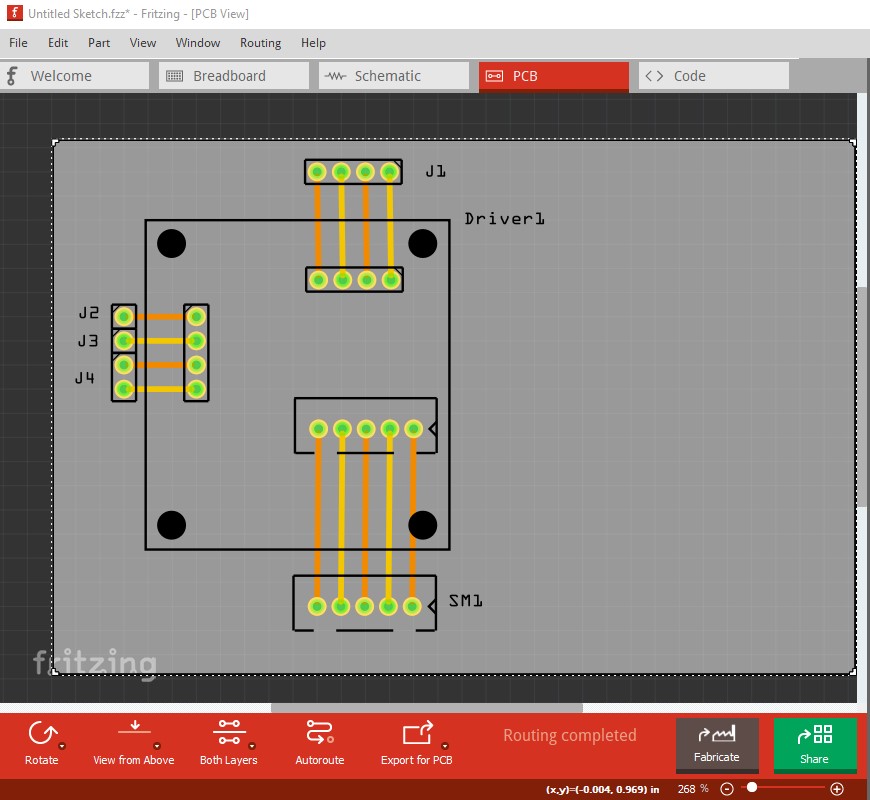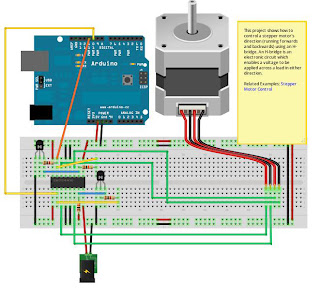

Meaning, pulling this pin low puts the driver in sleep mode, minimizing the power consumption. You can choose a different digital pin if you want, but these are the ones I used for this tutorial and the example code. The STP (step) and DIR (direction) pin are connected to digital pin 3 and 2 respectively.The GND pin (lower right) is connected to the ground pin of the microcontroller and VDD is connected to 5V.
 The two coils of the stepper motor are connected to 1A, 1B and 2A, 2B (see below). The motor power supply is connected to GND and VMOT (top right). The connections are also given in the following table: A4988 Connections A4988 This integrated motor driver makes interfacing with a microcontroller super easy as you only need two pins to control both the speed and the direction of the stepper motor. is a participant in the Amazon Services LLC Associates Program, an affiliate advertising program designed to provide a means for sites to earn advertising fees by advertising and linking to products on .Īt the heart of the A4988 driver you will find a chip made by Allegro MicroSystems: the A4988 DMOS Microstepping Driver with Translator and Overcurrent Protection. It makes wiring much easier and is a great option if you need a more permanent solution than a breadboard. Such a shield already includes capacitors and offers an easy way to select the microstepping resolution. I like to use this driver in combination with a CNC-shield or expansion board. I also have an article on How To Drive a Stepper Motor using the A4988 driver and ESP32 if you want to work with an ESP32 microcontroller instead. TB6600 Stepper Motor Driver with Arduino Tutorial. How to control a Stepper Motor with Arduino Motor Shield Rev3. 28BYJ-48 Stepper Motor with ULN2003 Driver and Arduino Tutorial. How to control a stepper motor with DRV8825 driver and Arduino. If you would like to learn more about other stepper motor drivers, then the articles below might be useful: This library is fairly easy to use and can greatly improve the performance of your hardware.Īfter each example, I break down and explain how the code works, so you should have no problems modifying it to suit your needs. I have included a wiring diagram, a tutorial on how to set the current limit and many example codes.Īlthough you can use this driver without an Arduino library, I highly recommend you also take a look at the example code for the AccelStepper library at the end of this tutorial.
The two coils of the stepper motor are connected to 1A, 1B and 2A, 2B (see below). The motor power supply is connected to GND and VMOT (top right). The connections are also given in the following table: A4988 Connections A4988 This integrated motor driver makes interfacing with a microcontroller super easy as you only need two pins to control both the speed and the direction of the stepper motor. is a participant in the Amazon Services LLC Associates Program, an affiliate advertising program designed to provide a means for sites to earn advertising fees by advertising and linking to products on .Īt the heart of the A4988 driver you will find a chip made by Allegro MicroSystems: the A4988 DMOS Microstepping Driver with Translator and Overcurrent Protection. It makes wiring much easier and is a great option if you need a more permanent solution than a breadboard. Such a shield already includes capacitors and offers an easy way to select the microstepping resolution. I like to use this driver in combination with a CNC-shield or expansion board. I also have an article on How To Drive a Stepper Motor using the A4988 driver and ESP32 if you want to work with an ESP32 microcontroller instead. TB6600 Stepper Motor Driver with Arduino Tutorial. How to control a Stepper Motor with Arduino Motor Shield Rev3. 28BYJ-48 Stepper Motor with ULN2003 Driver and Arduino Tutorial. How to control a stepper motor with DRV8825 driver and Arduino. If you would like to learn more about other stepper motor drivers, then the articles below might be useful: This library is fairly easy to use and can greatly improve the performance of your hardware.Īfter each example, I break down and explain how the code works, so you should have no problems modifying it to suit your needs. I have included a wiring diagram, a tutorial on how to set the current limit and many example codes.Īlthough you can use this driver without an Arduino library, I highly recommend you also take a look at the example code for the AccelStepper library at the end of this tutorial. 
This article includes everything you need to know about controlling a stepper motor with the A4988 stepper motor driver and Arduino.







 0 kommentar(er)
0 kommentar(er)
